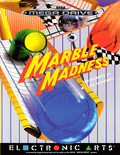
































Marble Madness

Marble Madness is an arcade video game designed by Mark Cerny, and published by Atari Games in 1984. It is a platform game in which the player must guide an onscreen marble through six courses, populated with obstacles and enemies, within a time limit. The player controls the marble by using a trackball. Marble Madness is known for using innovative game technologies. It was Atari's first to use the Atari System 1 hardware and to be programmed in the C programming language. The game was also one of the first to use true stereo sound; previous games used either monaural sound or simulated stereo.
In designing the game, Cerny drew inspiration from miniature golf, racing games, and artwork by M. C. Escher. He aimed to create a game that offered a distinct experience with a unique control system. Cerny applied a minimalist approach in designing the appearance of the game's courses and enemies. Throughout development, he was frequently impeded by limitations in technology and had to forgo several design ideas.
Upon its release, Marble Madness was commercially successful, becoming a profitable arcade game. Praise among critics focused on the game's difficulty, unique visual design, and stereo soundtrack. The game was ported to numerous platforms and inspired the development of other games. A sequel was developed and planned for release in 1991, but canceled when location testing showed the game could not succeed in competition with other titles.
Marble Madness is an isometric platform game in which the player manipulates an onscreen marble from a third-person perspective. The player controls the marble's movements with a trackball, though most home versions use game controllers with directional pads. The aim of the game is for the player to complete six maze-like, isometric race courses before a set amount of time expires. With the exception of the first race, any time left on the clock at the end of a race is carried over to the next one, and the player is granted a set amount of additional time as well. The game allows two players to compete against each other, awarding bonus points and extra time to the winner of each race; both players have separate clocks.
Courses are populated with various objects and enemies designed to obstruct the player. As the game progresses, the courses become increasingly difficult and introduce more enemies and obstacles. Each course has a distinct visual theme. For example, the first race (titled 'Practice') is a simple course that is much shorter than the others, while the fifth race (named 'Silly') features polka-dot patterns and is oriented in a direction opposite that of the other courses.
How to play:
Click on the joystick icon in the Marble Madness online emulator to see how to control the Marble Madness game









































Comments